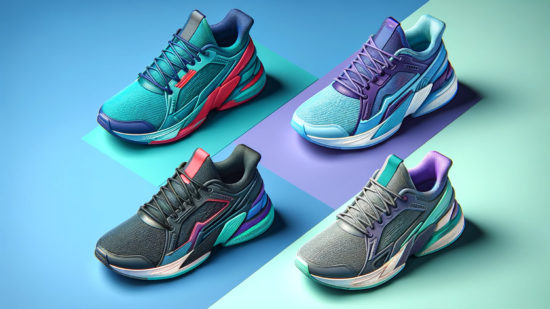Launching a global race for the metaverse took one resonant rebranding case. Following the CEO of Facebook, who announced the company’s rebranding to Meta and its subsequent corporate strategy toward immersive technologies, all tech giants initiated the development of their own metaverses. Although the first so-called metaverse, Second Life, was built in 2003, the craze about this revolutionizing technology is gaining momentum.
If you are an opportunistic entrepreneur willing to seize any rewarding chance to expand the business, what makes the metaverse attractive to users? The answer to this question implies that users must be able to associate themselves and others with animated 3D models. And these are called avatars.
As a business owner wanting to join the metaverse rush, you should decide how you want your virtual world to look and only inhabit it with virtual avatars. The best way to start your journey is to partner with a reliable 3D modeling company. For more insights on how to create metaverse avatars, read on!
What Is the Metaverse?

The metaverse, featuring the unique presence of metaverse avatars, is a concept that has its roots in science fiction, but it’s quickly becoming a reality thanks to technological advancements. The metaverse refers to a virtual reality space where metaverse avatars, representing users, can interact with a computer-generated environment and other users in real time. It’s a collective virtual-shared space created by converging virtually enhanced physical reality and physically persistent virtual reality.
In simpler terms, the metaverse is a digital universe, teeming with various metaverse avatars and consisting of multiple virtual worlds, both reality-based and entirely fictional, that exist parallel to our physical world. The metaverse is typically accessed using VR headsets, allowing metaverse avatars to fully immerse themselves in these virtual worlds. It can also be accessed using PCs and smartphones.
In the metaverse, metaverse avatars represent users — their digital counterparts that can be customized to their liking. These metaverse avatars can explore the metaverse, interact with other virtual avatars, participate in activities, and even own or trade virtual goods.
From a technological perspective, the metaverse and virtual avatars are the products of several emerging technologies. These include virtual reality (VR), augmented reality (AR), 3D computer graphics, and blockchain technologies, to name a few. These technologies combine to create immersive, interactive virtual worlds for metaverse avatars.
The metaverse concept, mainly focusing on metaverse avatars, has gained significant traction in recent years, thanks partly to technological advancements and increased interest from major tech companies. These companies envision a future where the metaverse becomes a significant part of our daily lives, where we work, play, and socialize via our metaverse avatars. This vision, while ambitious, is gradually becoming a reality, and as it does, it’s poised to redefine our understanding of what’s possible in the virtual world.
Why Should Businesses Enter the Metaverse?
The advent of the metaverse and the rise of metaverse avatars represents an evolution in digital engagement, providing an expansive, immersive platform where businesses can interact with their customers in unprecedented ways. By establishing a presence in the metaverse and creating metaverse avatars, businesses can create novel experiences that engage consumers and forge deeper emotional connections.
The metaverse, in essence, represents a new marketplace — a vast, digital ecosystem where metaverse avatars and the goods, services, and experiences they possess can be bought, sold, and traded. Virtual goods and digital real estate, already traded for real-world currency by metaverse avatars in certain metaverses, create new business opportunities. Additionally, blockchain integration enables secure transactions for metaverse avatars and the potential for innovative business models, such as tokenized ownership and fractional investments.
The metaverse also offers a unique avenue for brand expression in the virtual worlds via metaverse avatars. Businesses can design their metaverse avatars to align with their brand identity and values, creating virtual worlds and experiences that resonate with their target demographic. These virtual worlds, populated by brand-specific metaverse avatars, allow for impossible customization and interactivity in the physical world.
Furthermore, the metaverse enables businesses to gather rich data about customer behavior through the interactions of their metaverse avatars. Every interaction of metaverse avatars in the metaverse can be tracked and analyzed, providing businesses with valuable insights that can inform their marketing and business strategies. Privacy considerations are paramount, but the potential for understanding customer preferences and behavior in the metaverse through the lens of metaverse avatars is enormous.
Lastly, the metaverse, powered by the interactions of metaverse avatars, can facilitate collaboration and innovation within a business. Virtual workspaces can be designed for metaverse avatars to collaborate, brainstorm, and prototype, allowing teams across the globe to work together in the same virtual space. This ability to foster collaboration and creativity in the metaverse can lead to improved business processes and innovative ideas.
How Tech Leaders Profit From Creating Metaverse Avatars
![]()
Metaverses can function as platforms, marketplaces, games, and anything you’d like them to be. So the choice is yours regarding what setting, level of realism, and business model your virtual world will feature. Creating metaverse avatars can become profitable, given the number of related startups popping up daily.
You can define your unique niche in the industry and fit your future metaverse into it. Start off with researching what your potential competitors have in store for their clients. Meta is developing its metaverse, and it will be a social networking platform brought to a new level.
In turn, Microsoft has also announced building its own metaverse called Mesh for Microsoft Teams, a virtual platform for online meetings, conferences, and coworking. Astonishingly enough, you can enter some metaverses even today! For instance, the Ethereum-based NFT gaming metaverse Sandbox is already open for exploration.
All in all, the opportunities to benefit from creating metaverse avatars include:
- Advanced virtual avatar generator. With this option built into your metaverse, you can attract more users.
- Unique clothes, skins, and other virtual ‘accessories.’ Just like game players, your metaverse visitors will adore having a variety of outfits for their virtual avatars.
- Custom objects and collectibles. You can make your metaverse the best place to be by combining NFTs, most useful game mechanics, and metaverse avatars. Let alone turn it into a profitable business model!
Whether you are more into developing a custom virtual avatar generator or creating it for your use, you can reap the benefits through 3D model customization or in-built clothing stores.
Personalization and Customization of Metaverse Avatars
Personalization and customization are critical aspects of metaverse avatar design in the metaverse. These features enhance the user experience by allowing individuals to create distinct, unique metaverse avatars that reflect their personalities, preferences, or desired appearance. With virtual reality becoming more immersive, these metaverse avatars are not merely abstract icons but representations of individuals who interact, communicate, and form relationships within the virtual world.
For businesses, the potential of metaverse avatar personalization goes beyond individual identity expression. It provides an avenue to deepen customer engagement, improve brand loyalty, and foster a sense of community. Companies can offer customizable skins, clothing, or accessories for metaverse avatars that align with their brand image or promotional campaigns. Businesses can incorporate interactive elements that echo their products or services into their metaverse avatars. This enhances the user’s immersion and provides a unique platform for showcasing products and offerings through metaverse avatars.
However, this level of personalization and customization for metaverse avatars presents its own challenges. One of these is managing the balance between offering extensive customization options for metaverse avatars while maintaining a coherent and appealing aesthetic that aligns with the brand image. Overwhelming users with too many choices or creating a disjointed visual experience for their metaverse avatars can detract from user satisfaction. Businesses must carefully consider designing and implementing these customization options for their metaverse avatars to ensure they add value to the user experience.
Additionally, the technical complexities of implementing personalization at scale for metaverse avatars and across various platforms can pose a challenge. Solutions may involve advanced AI algorithms for automatic customization suggestions for metaverse avatars, robust 3D modeling tools for user-friendly design interfaces, or cross-platform compatibility solutions for seamless experience across different devices for the metaverse avatars.
What Kinds of Avatars Are Possible in the Metaverse?
While some metaverse avatars can be sufficiently realistic, others are cartoony. When developing metaverse avatars, you certainly don’t want your users to experience the Uncanny valley, a phenomenon whereby a person has a sense of unease or fear while viewing a humanoid-like face with unsettling features.
Every time your user sees one of the metaverse avatars, especially those with a robot’s facial expression resembling an actual human, they might feel revulsion, which is not what you expect upon entering a metaverse. 3D artists try to follow the golden mean when designing metaverse avatars to respond to this issue. In 3D visualization, this approach is often referred to as abstract-o-meter, a concept coined by a visual storyteller from the New Yorker magazine to define a perfect balance between hyper-realistic and cartoony humanoid characters, particularly when creating metaverse avatars.
Whereas one classification presupposes distinguishing between photorealistic and cartoony metaverse avatars, another is more business-oriented. Specifically, it’s about creating metaverse avatars for either corporate activity, like virtual meetings and collaboration, or entertainment, including, for example, gaming. Let’s go ahead and discuss both types of metaverse avatars in greater detail!
Metaverse Avatars for Corporate Activities
![]()
You can create metaverse avatars for further use inside organizations, which is a beneficial model from where to start entering the metaverse business environment. This initiative becomes exceptionally viable when considering modern trends in creating metaverse avatars. Some say you will be able to delegate work responsibilities to your metaverse avatars in the future.
In pursuit of profit, metaverse development companies heavily bet on metaverse avatars that will be put to good use for business conferences or regular online meetings. This has mainly become popular in the dawn of telecommunication tendencies following the COVID-19 pandemic. Since then, many companies have shifted to online communication platforms like Zoom, Skype, or Google Meet, making using metaverse avatars increasingly important.
No matter what devastating disasters shake the physical world, IT companies survive as long as they can access fiber-optic cables and hardware equipment. That’s why the industry depends on remote work, implying that the development of corporate metaverse avatars will always be in demand.
Metaverse Avatars for Entertainment Purposes
![]()
According to the 2022 survey, 16% of respondents were incredibly excited about creating their own metaverse avatars, while 25% were somewhat interested. Inveterate gamers make up most of this statistic when considering the audience for entertainment metaverse avatars, chiefly Gen Z and Millenials. They will become the end-users of your future metaverse avatars, so their opinions are precious.
Making virtual metaverse avatars for metaverse games can become an extremely profitable venture. You may not exclusively create metaverse avatars for games, but the digital entertainment industry offers endless business opportunities, mainly when dealing with metaverse avatars.
This industry remains highly profitable in light of the global market capitalization of Web 2.0 metaverse organizations (and it was $14.8 tn in 2021!). You’ll need a metaverse and a virtual avatar creation tool to join the market to inhabit your virtual world with real people and their metaverse avatars. Thus, move down below to learn how to create metaverse avatars optimally!
Metaverse Avatars’ Integration with Existing Business Processes
Metaverse avatars can serve as pivotal touchpoints between businesses and customers in the virtual world, augmenting existing business operations and opening up new avenues for interaction. Integrating metaverse avatars with business processes primarily hinges on mapping the customer journey and identifying where the virtual experience can complement and enhance real-world interactions.
For instance, customer service can be revolutionized by employing metaverse avatars as virtual assistants. These metaverse avatars can guide users through the metaverse, answer real-time queries, and provide a personalized experience, increasing customer engagement and satisfaction. Regarding product demonstration or marketing, businesses can use metaverse avatars to showcase their products or services in an immersive, interactive way, offering customers a first-hand experience that traditional online platforms cannot match.
Examples of successful integration abound. For instance, fashion retailers embrace the metaverse to extend their retail experience. Customers can use metaverse avatars to try on digital clothing, walk through virtual storefronts, and even attend fashion shows, bridging the gap between the online and offline shopping experience. Another example is the gaming industry, where metaverse avatars are a core part of the gaming experience, with players investing significantly in personalizing their metaverse avatars.
However, successful integration requires a carefully planned strategy. First, businesses need to understand their target audience’s needs and behaviors in the metaverse. It’s also crucial to leverage existing brand identity while adapting to the nuances of the metaverse and the use of metaverse avatars. A collaborative approach is often required, working with experts in areas like UI/UX design, 3D modeling, and blockchain technology.
Integrating metaverse avatars into business operations offers many opportunities to connect with customers on a deeper level, enhance brand visibility, and carve a unique position in the market. The answer to the question “how to create a seamless integration with metaverse avatars” lies in strategic planning, understanding customer behavior, and effective execution.
Metaverse Avatars and Digital Marketing
In the rapidly evolving digital landscape, metaverse avatars offer new and innovative ways for marketers to connect with audiences. In fact, the personalized nature of metaverse avatars and their immersive virtual worlds opens up exciting possibilities for digital marketing campaigns. Instead of simply seeing an advertisement, consumers can now interact with brands in a more engaging and memorable way through their metaverse avatars. They can try products virtually, participate in branded events, or interact with brand ambassadors as metaverse avatars, making marketing more experiential and customer-centric.
Consider, for example, how luxury fashion brand Balenciaga utilized metaverse avatars to launch its Fall 2021 collection in a video game format. Players used metaverse avatars to explore a virtual world filled with the brand’s latest designs, turning a traditional fashion show into an immersive, interactive experience that reached a global audience. In another instance, the famous beverage brand Coca-Cola created a virtual island in the metaverse for users to explore with their metaverse avatars, simultaneously promoting their brand while providing an enjoyable experience.
Looking forward, the future of digital marketing with metaverse avatars in the metaverse appears vibrant and full of potential. With advancements in virtual reality and AI technology, the interactions between brands and consumers through metaverse avatars in the metaverse will become increasingly sophisticated and personalized. In addition, gathering granular data about consumer behavior with metaverse avatars in the metaverse will enable marketers to create highly targeted campaigns and adjust their strategies in real time based on user feedback.
However, as businesses explore the vast potential of metaverse avatars in their digital marketing strategies, they must also be mindful of privacy concerns and ensure they create an environment that respects user data and fosters trust. Ultimately, with the help of metaverse avatars, the metaverse presents an exciting new frontier for digital marketing, promising a level of engagement and personalization that was previously unimaginable.
Monetizing Metaverse Avatars
The metaverse has opened up new business models and revenue streams, with metaverse avatars at the forefront of this commercial evolution. Businesses are capitalizing on the trend of virtual avatar personalization. They make money by selling various digital goods, from metaverse avatars’ clothing and accessories to virtual real estate and services. The concept of ‘skinconomy,’ where users pay real money to acquire custom skins or appearances for their metaverse avatars, has proven particularly profitable in gaming and is poised to expand across the Metaverse.
At the same time, businesses are exploring strategies such as advertising and sponsorships linked to metaverse avatars. For example, a company could pay to have its logo featured on a popular metaverse avatar’s clothing or sponsor a virtual event where metaverse avatars can interact uniquely with the brand. Another promising strategy is the development of play-to-earn models, where users earn real or cryptocurrency rewards for activities or achievements completed by their metaverse avatars in the metaverse.
However, monetizing metaverse avatars is not without its legal and ethical considerations. Businesses must navigate intellectual property rights as user-created content becomes a significant part of the metaverse economy. User privacy and data security are critical considerations, mainly as monetization strategies often rely on gathering user data related to metaverse avatars. Lastly, businesses must consider the ethical implications of their monetization strategies, ensuring they promote a fair, inclusive, and safe metaverse environment for all metaverse avatars.
While monetizing metaverse avatars presents exciting business opportunities, it also requires careful navigation of legal and ethical considerations. As the metaverse continues to evolve and the use of metaverse avatars continues to grow, businesses must stay ahead of these issues, balancing the pursuit of revenue with the need to maintain user trust and create a positive metaverse experience for all metaverse avatars.
Data and Privacy of Metaverse Avatars
Data collection and privacy issues emerge as crucial concerns in the expansive virtual world of the metaverse, where virtually every movement, interaction, and transaction of metaverse avatars is potentially trackable. The virtual avatars, serving as digital alter egos of individuals, participate in various activities, from social interactions and digital commerce to virtual exploration and personal customization. These activities generate a wealth of personal data unique to the metaverse environment. The volume and granularity of this data, coupled with the deeply personal nature of many metaverse experiences involving metaverse avatars, make privacy a concern of paramount importance.
One of the critical issues related to data and privacy in the metaverse is the potential for misuse or mishandling of the collected data from metaverse avatars. The wealth of detailed personal data collected in the metaverse can be attractive to malicious actors and vulnerable to data breaches.
Additionally, there is a risk that data gathered from metaverse avatars could be used for purposes that the user hasn’t explicitly consented to, such as targeted advertising based on personal habits or preferences. This is not merely a theoretical concern; the history of data breaches and privacy scandals in the technology and social media industries is a stark reminder of what can happen when personal data related to metaverse avatars is not adequately safeguarded.
Building customer trust in the metaverse, particularly about metaverse avatars, is a challenge that businesses must rise to, and the key to this is an uncompromising commitment to data privacy. Transparency is a crucial element of this commitment. Users of metaverse avatars need to be fully aware of what data is being collected, how it is being used, and with whom it might be shared. Businesses should not assume consent; instead, they must seek explicit user permission, offering easy and accessible ways for users to opt out of data collection from their metaverse avatars. Furthermore, advanced data security measures such as encryption should be employed to protect personal data from breaches. But this is just the starting point.
In addition to these measures, businesses should consider adopting a privacy-by-design approach when developing their metaverse offerings, especially those involving metaverse avatars. This involves integrating privacy considerations into every product or service development stage, from the initial design phase to the user experience. By doing this, businesses can ensure that privacy isn’t just an add-on but a fundamental aspect of their Metaverse platform.
Yet, the responsibility of businesses extends beyond their individual platforms. As pioneers in the metaverse, businesses have a crucial role in advocating for and adhering to robust, industry-wide privacy standards and regulations that protect the privacy of metaverse avatars. With its ability to transcend national boundaries, the metaverse demands a global consensus on privacy norms and ethical guidelines. Recent controversies, such as unauthorized sales of user data by third-party apps or inadequate privacy controls that exposed sensitive user information, have highlighted the urgent need for comprehensive, universally accepted data privacy regulations in the metaverse.
The issue of data and privacy in the metaverse, especially regarding metaverse avatars, cannot be sidelined or treated as an afterthought. As businesses tap into the enormous potential of this new digital frontier, they must place data privacy at the core of their strategies and operations. This involves protecting their own users’ data and actively shaping the broader privacy landscape of the metaverse. By doing so, businesses can contribute to building a secure, trusted, and sustainable virtual world ecosystem that respects users’ privacy rights and ensures a safe and enjoyable metaverse experience for all metaverse avatars.
User Experience and Interface Design
User experience (UX) and user interface (UI) design become increasingly crucial when considering how to create metaverse avatars. Like traditional virtual worlds, metaverse avatars’ UX and UI design can distinguish between an engaging, intuitive experience and a frustrating, confusing one. In the Metaverse, metaverse avatars are the primary medium of user interaction, and their design — in terms of aesthetics and functionality — significantly impacts the overall user experience.
User experience design for metaverse avatars revolves around creating a seamless, engaging, and intuitive interaction between the user and their digital representation. This involves understanding user needs and behaviors, mapping out user journeys within the metaverse using metaverse avatars, and continually refining virtual avatar interactions to ensure they meet user expectations. User interface design, on the other hand, is about creating an intuitive, aesthetically pleasing, and responsive virtual avatar control system that allows users to navigate and interact within the metaverse easily with their metaverse avatars.
Businesses can optimize UX and UI for their metaverse avatars by integrating user feedback into the design process, ensuring they are accessible to a diverse user base, and staying current with advancements in metaverse technologies. Given the immersive nature of the metaverse, businesses should also consider incorporating elements of virtual reality (VR), augmented reality (AR), and artificial intelligence (AI) into their UX/UI design strategies, enhancing the realism and interactivity of their metaverse avatars.
A prime example of effective UX and UI design for metaverse avatars in the metaverse comes from the popular game Fortnite. The game’s interface is simple and intuitive, allowing players to easily control their metaverse avatars and interact with the virtual world. Yet, it also provides depth, offering various customizations and interactions that enhance the player’s immersion and engagement.
Another good example is Facebook’s Horizon Workrooms, a virtual reality application for remote work. Users control their metaverse avatars to interact in a virtual workspace, manipulating objects and collaborating on tasks. The interface is designed to be intuitive, with clear visual cues and a straightforward control system, making it easy for first-time users to navigate the space with their metaverse avatars.
So, how to create incredible metaverse avatars? Businesses must prioritize UX and UI design in their metaverse avatar strategy as the metaverse evolves. Doing so can ensure a smooth, enjoyable, and engaging user experience, encouraging users to spend more time in the metaverse and interact more deeply with their brands through their metaverse avatars. This requires a deep understanding of user needs and behaviors, a commitment to continuous refinement and innovation, and a willingness to embrace the opportunities presented by VR, AR, and AI technologies to design and improve metaverse avatars.
How to Create a Metaverse Avatar and Get It Right
Dozens of reliable services are helping people create unique metaverse avatars based on their selfies. However, not all of them provide all-in-one software-based solutions tailored to your product requirements when creating metaverse avatars.
You may need a metaverse avatar creator developed just for you or a collection of unique metaverse avatars with an option for further customization. Depending on your target audience, business model, and strategy, you’ll require a different approach to building metaverse avatars. Building the metaverse and a custom virtual avatar creator can prove a fruitless initiative.
To reduce the risks and remain cost-efficient, it’s better to cooperate with professionals while creating metaverse avatars. Experts from the 3D-Ace team know how to create metaverse avatars easily, so none of your issues will be left unresolved in creating metaverse avatars. If you want to know why using an AI-based metaverse avatar generator (especially if it’s free) is terrible for businesses, dive into the next section!
AI Avatar Generators — Why a Bad Idea for Now?
Beyond question, AI metaverse avatar generators can prove not the worst idea for people willing to join some virtual world as users. Still, whenever it comes to enterprises or startups, they should think twice. Why? Well, there are at least three reasons:
- Lack of customization. As of today, all these metaverse avatar generators working on artificial intelligence can’t offer a unique experience for business owners or their target audiences when creating metaverse avatars.
- Cybersecurity issues. Furthermore, when AI-based metaverse avatar creation solutions are free, chances are that user data can be compromised since they often require sharing access to one’s personal photos.
- Inconvenience. You don’t want your customers to use third-party virtual avatar creation services if you already have a metaverse. This approach entails inconvenience, redundant negotiations, and poor user experience for your audience when dealing with metaverse avatars.
As a result, AI avatar generators can’t be a beneficial option for corporate use in creating metaverse avatars. So, how to create metaverse avatars without these tools? The solution would be to cooperate with an art studio to outsource the development of custom metaverse avatars or their smart generator.
How to Create Realistic Characters with Human 3D Scanning
Unlike AI avatar generators, lacking creativity and hyper-realism, which typically entails the emergence of an Uncanny Valley, human 3D scanning isn’t a wrong choice. Photogrammetry may become your best friend if you need humanoid characters for your metaverse. In fact, this technology allows you to create realistic 3D scans out of actual physical objects and saves you financial and time resources spent on experienced 3D artists.
Nowadays, 3D scan cleanup services help a wide range of companies create realistic and well-optimized characters for various projects. Once a raw 3D scan undergoes retopology, retexturing, and geometry improvement sprints, it can be imported into a game engine. If your product requires many humanoid characters, human 3D scanning is your perfect match. Still, projects featuring unrealistic models may require a different approach.
Customized Virtual Avatars by a Professional Art Studio
If you intend to step into the metaverse industry and play smart, the question of how to create a metaverse character shouldn’t be a priority. A better alternative is to consider where and how to have a metaverse avatar generator developed for you. Also, it’s often rewarding to inquire about your business needs and discuss them with reliable partners.
The first option is to contact an art studio and get a series of custom avatars, 3D models, or skins for further use. The second option involves partnering with a software development company interested in making a metaverse avatar generator for your future users. After all, to create metaverse characters in a quality program tailored to your target audience — is a unique experience for users.
Future Trends of Metaverse Avatar Development
As the metaverse evolves, the business applications of metaverse avatars are poised to transform in step with advancing technology and shifting user expectations. We can anticipate several future trends shaping the usage and impact of metaverse avatars in the business landscape.
-
Firstly, expect a surge in avatar-based marketing and customer service using metaverse avatars. Metaverse avatars can serve as brand ambassadors, sales agents, or customer support reps, delivering personalized, immersive experiences that outpace traditional digital methods. Businesses should start strategizing on creating metaverse avatars and incorporating them into their customer-facing operations.
-
Secondly, with AI and machine learning improvements, metaverse avatars will become more autonomous, capable of learning from interactions and evolving over time. This could revolutionize areas like customer service, data collection, and personalized marketing. Businesses should consider investing in AI technology and upskilling their teams to prepare for these advancements in developing metaverse avatars.
-
Thirdly, the intersection of the metaverse with blockchain technology is expected to spur the rise of decentralized metaverses, where users have ownership and control over their metaverse avatars and virtual assets. Businesses should familiarize themselves with blockchain and consider how a decentralized Metaverse could impact their strategies involving metaverse avatars.
-
Finally, as the metaverse becomes more integrated into everyday life, there will be increasing demand for cross-platform metaverse avatars that can move seamlessly between different virtual worlds. Businesses must design and create their metaverse avatars with interoperability in mind.
In preparation for these trends, businesses should focus on staying abreast of the latest technological advancements in the metaverse avatars, understanding metaverse users’ evolving needs and preferences, and developing adaptable strategies for their metaverse avatars. As the metaverse continues to grow and transform, businesses anticipating and adapting to these changes in the virtual worlds of metaverse avatars will be best positioned to succeed.
Craft Custom Metaverse Avatars with 3D-Ace Services
Are you still wondering how to create your own metaverse avatar, or has the time come to build an avatar creator to expand the spectrum of experience your users might have after plunging into your metaverse? 3D-Ace is the best place to start your journey across the industry of metaverses and virtual avatars inhabiting them.
The easiest way to launch your metaverse avatars project is to contact us and discuss all the details before jumping right into development!









